1. Statement of Contribution
The Police and Crime Commissioner’s (PCC) ‘Police and Crime Plan 2021-2025’ was formally published on 31 March 2022, the objectives set within the plan have been formulated with the National Crime and Policing Measures (NC&PM) priorities in mind.
To ensure delivery against the NC&PM, the PCC wants to ensure that all agencies are working together to reduce crime, support victims and make communities safer. This will be achieved through regular engagement with local communities, the police, partners, and community safety organisations.
The PCC’s position as the Chair of the Local Criminal Justice Board enables him to monitor the provision of an effective and efficient criminal justice system in Warwickshire.
In terms of the PCC to ‘hold to account’ the chief constable for the performance of Warwickshire Police, the PCC holds a formal monthly Governance and Performance Board (GPB) meeting with the chief constable. The purpose of the GPB is to focus on specific areas of force performance and the meeting is also attended by senior officers and staff from both the force and the OPCC. At each GPB a topical ‘Focus’ subject of particular interest is selected for in-depth scrutiny and discussion. The minutes of the meetings are published on the OPCC website.
2. Warwickshire Police Overview
The NC&PM are set to be monitored on a quarterly basis. There is an expectation that PCC’s will explain how their force is performing against the measures (Specified Information Order).
At the March 2023 meeting of the GPB, the force’s performance during Q3 2022/23 was scrutinised, including against the NC&PM metrics. The Government uses June 2019 as the NC&PM data baseline, against which current performance is compared and assessed.
Whilst there are national measures against the six priority areas, some of these are not available or appropriate for the force to report against. For example, against the priority ‘reduce serious violence’, one of the national metrics is hospital admissions of under 25’s for assault with a sharp object. This is not data held by the police and the force are not able to assess its reliably.
The force has therefore selected some additional proxy measures which will be used to assess Warwickshire’s contribution against the national priorities. It is expected the force will continue to develop its approach with the OPCC to ensure it is appropriately aligned with the national position.
3. Performance Q3 2022/23
3.1. Reduce Murder and Other Homicide
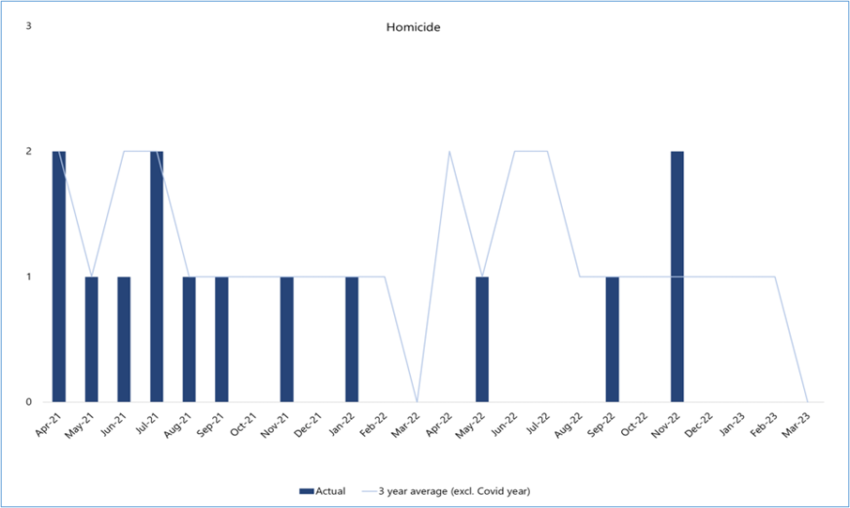
Figure 1 – Graph of Homicide Rates
Force Commentary
Warwickshire Police are not considered to be an ‘outlier’ by the Home Office
Fortunately, Warwickshire has a relatively small number of homicides, with only four recorded in year-to-date 2022/23.
In line with NPCC direction, we are completing a Homicide and Near Miss Problem profile which will be ready for circulation in February 2023.
OPCC Commentary
The comments in the Performance Report are noted regarding the small number of homicides committed in Warwickshire, with four recorded this fiscal year. There were however two homicides recorded in Q3 2022/23, although it is understood that there were no themes identified in term of the causational factors for these deaths.
The additional comments are noted regarding the method the Home Office use to identify a force as an ‘outlier’, and that Warwickshire Police is currently not considered to be such.
The further comments regarding the National Police Chief’s Council’s request for a ‘problem profile’ of homicide and ‘near misses’ in Warwickshire is a positive development, as it will enable a better understanding of the position and identify areas for improvement. It is understood that this will be available in February 2023 and its production is awaited with interest.
The PCC discussed the subject of Homicide with the Chief Constable as a Focus topic at a ‘holding to account’ Performance Accountability meeting in March 2023. The minutes of this meeting are openly available on the OPCC website.
3.2. Reduce Serious Violence
The Govt. measures are: –
- a) Hospital admissions for persons under 25 years old injured with sharp instrument (NHS).
- b) Offences involving discharge of a firearm.
The force’s proxy measures are: –
- a) Offences involving the use of a firearms.
- b) Offences involving knife crime or sharp instruments.
- c) Serious violence (Violence with Injury / Robbery).
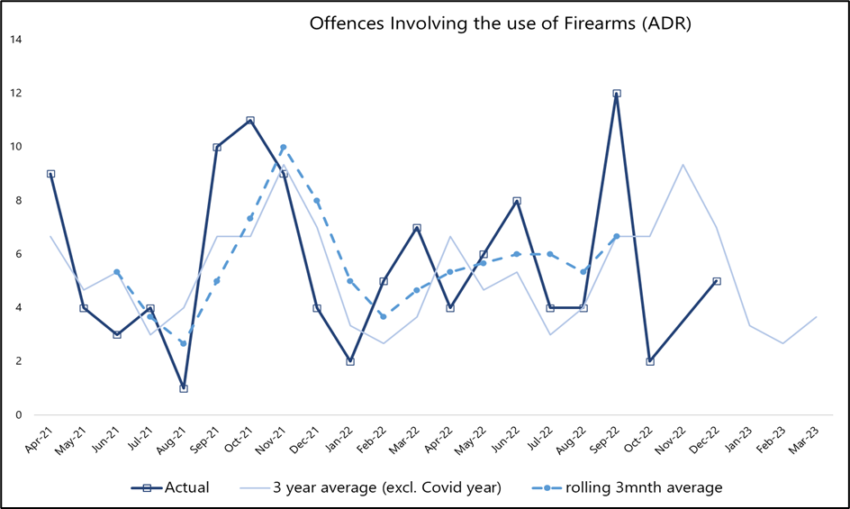
Figure 2 – Graph of Offences Involving Firearms
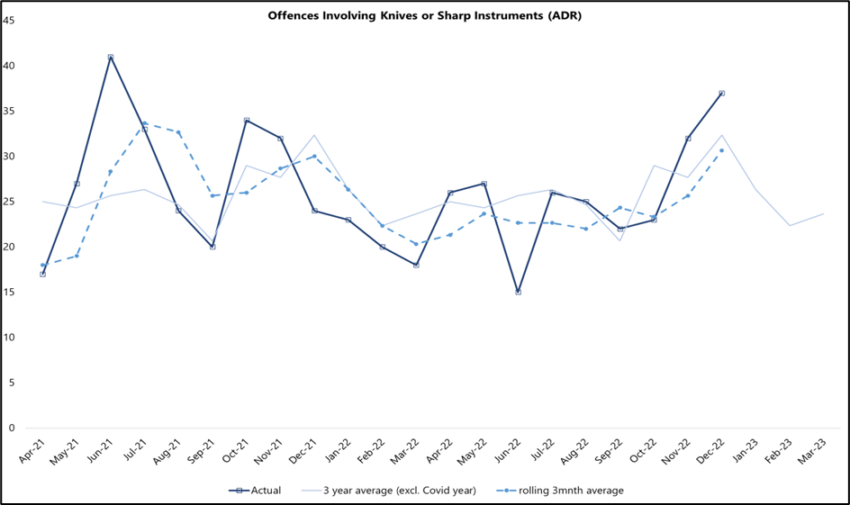
Figure 3 – Graph of Offences Involving Knives or Sharp Instruments
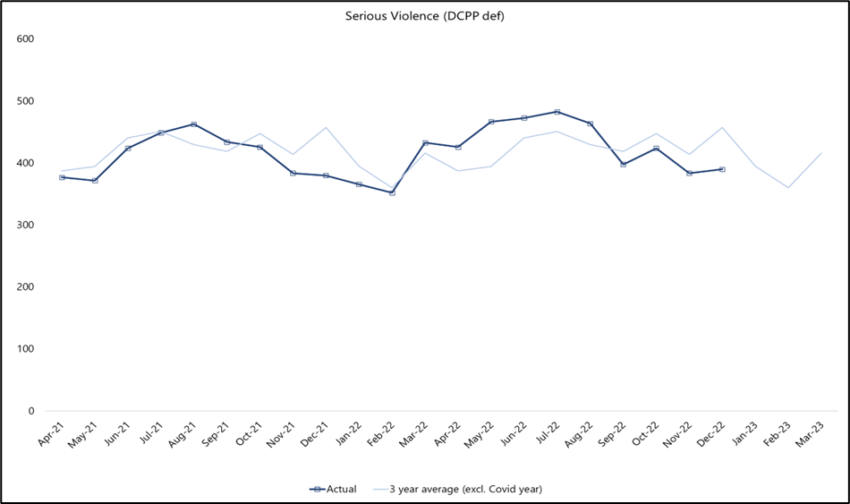
Figure 4 – Graph of Serious Violence
Force Commentary
Warwickshire Police are not considered to be an ‘outlier’ by the Home Office
The Home Office assess the measure of ‘Reduce Serious Violence’ using NHS data for hospital admissions for assault with a sharp object. The latest available data, displayed on the HMICFRS Digital Crime and Performance Pack, is to June 2022. This shows very low numbers in Warwickshire of 10 admissions in the latest 12-months. This is in line with Warwickshire Police’s Most Similar Group (MSG) of police forces with an average of 11 admissions.
As a proxy measure, we are also commenting on recorded serious violence offences. Volumes are lower in the last 12-months compared to the June 2019 baseline and are very similar in the last 6-months (Jul-Dec) compared to the same period in 2021. This is also reflected in firearms offences.
For offences involving knives or bladed instruments, current volumes are slightly below the June 2019 baseline and the comparative 6-months last year.
OPCC Commentary
A comprehensive multi-agency Serious Violence Reduction Strategy has been formulated for the county and the OPCC are currently in the process of contributing to the associated Delivery Plan, which will incorporate the reduction of knife crime and the removal of prohibited weapons.
From the performance data presented, it is a positive position that there have been reductions in all three measures during the last 12-months period when compared to the baseline, however there is evidence of a sharp increase in the volume of Knife Crime offences during the last two months. A question was consequently raised on this matter by the OPCC with the chief constable at the GPB in March 2023: –
Q. Are the causes for the recent increase in Knife Crime / Sharp Instrument well understood, and what proactive measures are being taken to reduce these levels? This is particularly important given the ‘fear of crime’ that knife crime causes to Warwickshire’s communities?
A. Warwickshire Police provided the following response to the question: –
- Operation Sceptre sits within the violent crime reduction plan, under the prevention element within Local Policing. In 2022, Local Policing ran two operations during the national campaign windows. These were well received and in addition to various operational activities, the use of QR codes was trialled within fast-food outlets to raise awareness of the issues associated with knife crime and how to access help and advice.
- We continue to monitor the current trend in knife crime to see whether this is natural statistical variation in the figures (such as was seen in June 21) or a more concerning trend. Work continues to tackle knife-enabled crime, particularly in relation to county lines and urban street gangs.
- The force is engaging with key partners in relation to the Serious Violence Duty, knife crime will form one part of this wider strategic work to reduce serious violence across Warwickshire.
3.3. Disrupt Drug Supply & County Lines
The Govt. measures are: –
- a) Drug Related Homicide.
- b) Police Referred Drug Treatment (supplied by Public Health England).
The force’s proxy measures are: –
- a) Drug related homicides.
- b) Organised Crime Group (OCG) disruption.

Figure 5 – Graph of Disruptions
Force Commentary
None of the three homicides recorded in the last 12-months are noted as being drug related.
Disruptions of Organised Crime Groups and County-lines are submitted to, and ratified by, the Regional Organised Crime Unit. In Q3 2022/23 the number of disruptions has returned to levels seen in previous quarters after the notable increase in the previous Q2.
OPCC Commentary
The comments in the Performance Report are noted regarding none of the three homicides recorded in the last 12-months being drug related. Also, that during Q3 2022/23 there was a notable levelling-off in the number of enforcements against OCGs when compared to the exceptional levels achieved in Q2 2022/23, during a period of intensification.
A key priority for the Police and Crime Plan 2021-2025 is to Fight Crime and Reduce Reoffending, with a focus on Violent Crime and Organised Crime. The plan provides a narrative as to how this will be achieved and the measures by which the success of the plan will be measured.
The PCC will continue to closely monitor performance and ‘hold to account’ the chief constable in this area of considerably public concern.
3.4. Reduce Neighbourhood Crime
The Govt. measures are: –
- a) Burglary.
- b) Robbery.
- c) Theft Person.
- d) Theft from, and of, vehicle (Crime Survey England & Wales – CSEW)
The force’s measures are: –
- Relevant Home Office Recorded Crime Categories.

Force Commentary
The current levels of Neighbourhood Crime are significantly lower than the baseline level (12- months to June 2019). There was a significant reduction in neighbourhood crime linked to Covid 19 and whilst levels have remained lower, as restrictions have eased we have seen some increases.
Previously, the Home Office identified Warwickshire Police as an outlier for neighbourhood crime, and specifically for vehicle crime. This is driven by the comparison of our performance against the MSG. Warwickshire has always suffered with this comparison for vehicle crime, given its the proximity to West Midlands Police, who also seen a recent ‘spike’ in vehicle crime.
However, using the most recent data available, we would no longer be regarded as an outlier for Neighbourhood Crime following reduced volumes of recorded offences across each of the crime types. Nonetheless, when viewed in isolation, Warwickshire would remain an outlier for vehicle crime.
As a result of this the force has been developing plans to combat vehicle crime including, creating a dedicated operational lead, and working jointly with other forces in the region.
OPCC Commentary
The comments in the Performance Report are noted regarding the levels of Neighbourhood Crime being significantly lower than the baseline June 2018/19 and therefore the force is currently not considered to be an outlier for Neighbourhood Crime.
In the previous Q2 2022/23, the Home Office identified Warwickshire Police as an outlier. This position related to elevated levels of the sub-category of Vehicle Crime driven by the comparison of the force’s performance with its Most Similar Group (MSG) of police forces, where Warwickshire has historically suffered due to its proximity to the metropolitan West Midlands area and its crime profile.
At the August 2022 meeting of the GPB, a question on this matter was consequently raised regarding the action to be taken to address Neighbourhood Crime. It is therefore positive to note the comments in the December 2022 Performance Report that following reduced volumes of recorded offences across each of the crime types, the force is no longer considered to be an outlier.
Nonetheless, Warwickshire Police remains an outlier for the sub-category of Vehicle Crime, despite the action that the force has initiated to address this matter. The elevated levels of vehicle crime therefore remain a concern and in response the force has produced a Vehicle Crime Strategy and embarked upon Operation Calderwood.
A question was consequently raised by the OPCC with the force at the GPB in March 2023 on this matter: –
Q: In August’s 2022 GPB meeting the PCC was advised that the Vehicle Crime Strategy was to be reviewed, refreshed, and reinvigorated. Has this happened, if so, how do you expect the strategy to positively impact on vehicle crime rates?
A: Warwickshire Police provided the following response to the question: –
- The vehicle crime strategy has been reviewed and a new tactical response to vehicle crime developed and delivered under Operation Calderwood. Working with the Intelligence Department, and more closely with regional partners and bordering forces, we have a much better understanding of the differing vehicle crime threats within the county.
- The force is now deploying officers in a far more evidence-based approach to tackle theft from motor vehicle, theft of motor vehicle and freight crime. Dedicated taskings are created and refreshed and monitored/driven by the duty superintendent. Weekly vehicle crime figures and trends are also monitored and responded to by the teams responsible for the specified crime type. OPU/Patrol/SNT and Proactive CID are all playing their part to make Warwickshire an unappealing place to commit vehicle crime.
- Vehicle crime rates across the country continue to rise and this trend is also being seen across the region. We are content that the strategy brings a proportionate focus on vehicle crime, and with a number of key arrests already made, we would anticipate a stabilisation of vehicle crime figures in the near term, with a fall in vehicle crime in the mid to long term.
3.5. Tackle Cyber Crime
The Govt. measures are: –
- a) Confidence in law enforcement response.
- b) Percentage of businesses experiencing cyber-crime. Data taken from non-police sources.
The force’s proxy measures are: –
- a) Action Fraud cyber dependent victim referrals where advice given.
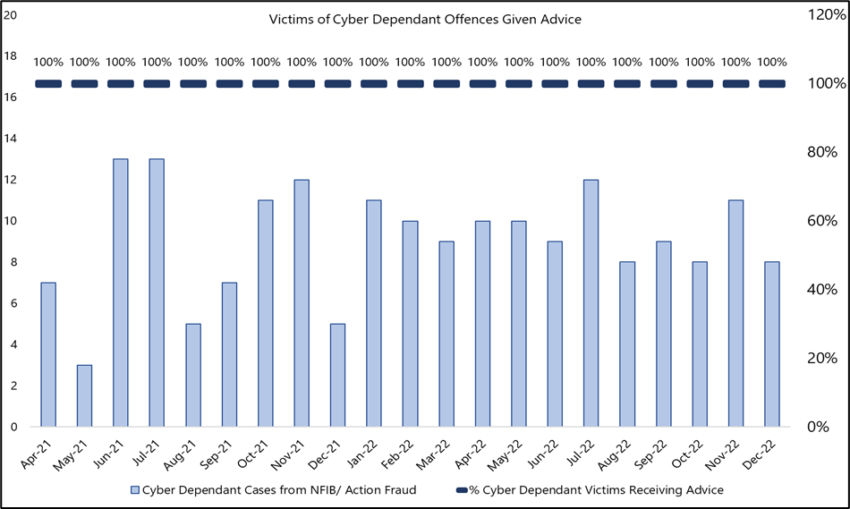
Figure 7 – Graph of Cyber Crime Rates
Force Commentary
The proposed national measures are not available at force level.
The force continues to achieve 100% in terms of providing advice to victims of cyber-dependent crimes. The levels of offences are based on cyber-dependent cases passed to us from the National Fraud Intelligence Bureau and the levels are broadly stable.
The force also continues its programme of proactive messaging with the Cyber Protect social media campaign reaching over 1.4million people in 2022 and the highest levels of engagement across the region this quarter. Specific campaigns have targeted Black Friday/ Cyber Monday, Xmas, and Student Cyber Safety.
OPCC Commentary
The comments in the Performance Report are noted regarding the force providing advice to victims of cyber-dependent crime in 100% of cases. Also, the force continues its programme of proactive messaging with the Cyber Protect social media campaign.
3.6. Improve Satisfaction Among Victims
The Govt. measures are: –
- a) Victim satisfaction with police by victims of domestic abuse.
- b) Victim satisfaction with police (CSEW) – Not available.
The force’s proxy measures are: –
- a) Force’s own domestic abuse victim satisfaction survey (not comparable with other forces).

Force Commentary
The satisfaction levels for Domestic Abuse have remained stable over the last quarter.
OPCC Commentary
The force’s 6-month rolling rate for domestic abuse victim satisfaction remained stable at circa 82% during Q3 2022/23. This position represents a slight improvement of 1% on the previous Q1 and Q2 2022/23, but a notable 8% increase on the same period in Q3 2021/22 – a positive development!
